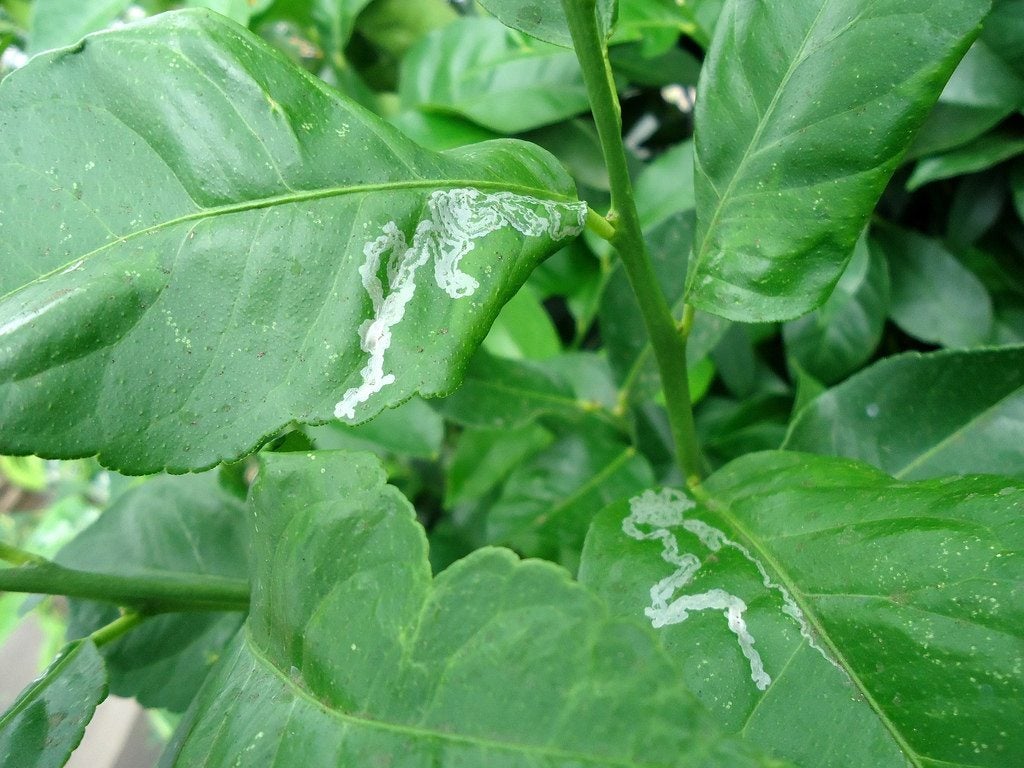Citrus Leaf Miner Control: How To Spot Citrus Leaf Miner Damage
If you see signs of leaf miner damage in your young citrus trees, using horticultural soaps, neem oil or predatory insects can help you control them. In fully grown trees they won't cause as much harm.


The citrus leaf miner (Phyllocnistis citrella) is a small Asian moth whose larvae dig mines in citrus leaves.
First found in the United States in the 1990s, these pests have spread into other states, as well as into Mexico, the Caribbean islands and Central America, causing citrus leaf miner damage.
If you think your orchard might be infested by citrella leaf miners, you’ll want to learn techniques for managing them. Read on for information on citrus leaf miner damage and what you can do about it.
About Citrella Leaf Miners
Citrus leaf miners, also called citrella leaf miners, are not destructive in their adult stage. They are very small moths, so minute that they are rarely even noticed. They have silvery white scales on their wings and a black spot on each wingtip.
The female leaf miner moths lay their eggs one by one on the underside of citrus leaves. Grapefruit, lemon and lime trees are the most frequent hosts, but all citrus plants can be infested.
Tiny larvae develop and mine tunnels into the leaves. Pupation takes between six and 22 days and happens within the leaf margin. Many generations are born each year. In Florida, a new generation is produced every three weeks.
Citrus Leaf Miner Damage
As with all leaf miners, larval mines are the most obvious signs of citrus leaf miners in your fruit trees. These are the winding holes eaten inside the leaves by the larvae of citrella leaf miners.
Gardening tips, videos, info and more delivered right to your inbox!
Sign up for the Gardening Know How newsletter today and receive a free copy of our e-book "How to Grow Delicious Tomatoes".
Only young, flushing foliage is infested. The mines of citrus leaf miners are filled with frass, unlike those of other citrus pests. Other signs of their presence include curling leaves and rolled leaf edges where pupation occurs.
If you notice the signs of citrus leaf miners in your orchard, you may be worried about the damage that the pests will do. However, citrus leaf miner damage is not very significant in a home orchard. Remember that the larvae of citrella leaf miners do not attack or damage the citrus fruit, but only the leaves. That may mean that you have to make the effort to protect young trees since their development can be affected by the infestation, but your crop may not be damaged.
Citrus Leaf Miner Control
Managing citrus leaf miners is more a concern of commercial orchards than those with one or two lemon trees in the backyard. In Florida orchards, growers rely on both biological control and horticultural oil applications.
Most citrus leaf miner control occurs via the insect’s natural enemies. These include parasitic wasps and spiders that kill up to 90 percent of larvae and pupae. One wasp is the parasitoid Ageniaspis citricola that accomplishes about a third of the control work itself. It is also responsible for managing citrus leaf miners in Hawaii as well.

Teo Spengler is a master gardener and a docent at the San Francisco Botanical Garden, where she hosts public tours. She has studied horticulture and written about nature, trees, plants, and gardening for more than two decades. Her extended family includes some 30 houseplants and hundreds of outdoor plants, including 250 trees, which are her main passion. Spengler currently splits her life between San Francisco and the French Basque Country, though she was raised in Alaska, giving her experience of gardening in a range of climates.
-
 Looking For Plants To Give You The Soft And Fuzzies? Try These 5 Fuzzy Leaf Plant Options
Looking For Plants To Give You The Soft And Fuzzies? Try These 5 Fuzzy Leaf Plant OptionsLovers of texture, drama, silver foliage and tactile plants will adore these special sensory garden additions. These fuzzy leaf plant options will leave you all aglow
By Susan Albert
-
 Get Ready For A Summer Of Hummers! Grow These Full Sun Hummingbird Plants and Flowers
Get Ready For A Summer Of Hummers! Grow These Full Sun Hummingbird Plants and FlowersIf you’re lucky enough to enjoy a sunny backyard, make sure you are maxing out on your pollinator opportunities and grow these full sun hummingbird plants and flowers
By Tonya Barnett